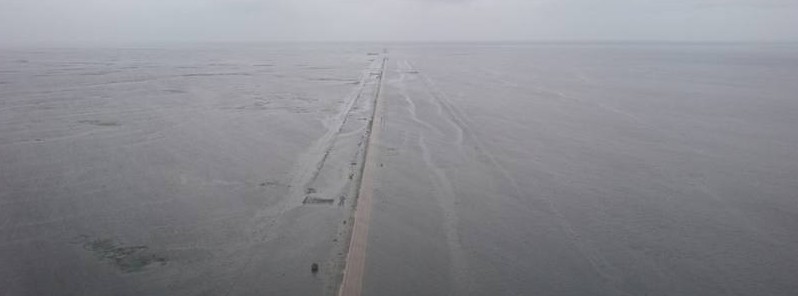Broome hit by two years’ worth of rain in two months, Western Australia

The town of Broome in the Kimberley region of Western Australia has officially endured its wettest year on record after just two months in 2018. Although January and February are usually its wettest months, updated figures show Broome was hit more than two years' worth of rain in just 50 days.
The town of Broome registered a total of 1 502.6 mm (59.15 inches) of rain this year by February 19, breaking by far its previous highest total to the end of February of 1 074.8 mm (42.31 inches) set in 1997. Broome's median annual rainfall is 528.0 mm (20.78 inches) and mean 614.5 mm (24.19 inches).
Since records in this region began in 1939, there were only three occasions when January and February rainfall combined approached the 1997 record – in 1974 with 915.2 mm (36.03 inches), 1978 with 948.4 mm (37.33 inches) and 1982 with 963.4 mm (37.92 inches).
With more than 1 500 mm in two months, 2018 smashed them all by far, even the town's wettest full year on record – 2000 with 1 496.6 mm (58.92 inches).
Tropical Cyclone "Kelvin" hit the region on Sunday, February 18 bringing wind gusts of up to 150 km/h (93.2 mph) and wettest day in February with over 370 mm (14.56 inches) of rain in a 24-hour period. This pushed Broome's February rainfall to 557.2 mm (21.93 inches), breaking its previous February record of 495.6 mm (19.51 inches) set in 1999 by 61.6 mm (2.42 inches), 10 days before the month's end.
All that rain flooded the region and turned the Great Northern Highway into an inland sea for the second time this month, isolating Broome again. Authorities used airplanes and helicopters to drop supplies to communities cut off by flooding.
Kelvin was downgraded to a tropical low on February 19 but will continue to bring heavy rains and gale-strength winds up to 100km/h (62 mph) as it heads southeast across the interior.
Somewhere underneath all this water is the Great Northern Highway. #Broome supermarkets are being stocked by barge until floodwaters recede and the damage to inundated roads can be assessed.
Check road conditions and closures at https://t.co/d2w9WHWnVD pic.twitter.com/gmfNVSAzT6
— ABC Emergency (@ABCemergency) February 20, 2018
This region was hit by Tropical Cyclone "Joyce" in January and devastated by a tropical low at the end of January with record-breaking 5-day rainfall, making January 2018 its wettest month in history with a total rainfall of 942.2 mm (37.09 inches).
BOM meteorologist Steph Bond said that the conditions produced by the tropical low were similar to a category one tropical cyclone. However, the weather event did not meet the criteria to be labeled a tropical cyclone and named. Nevertheless, the region was devastated by the weather event and Bond called it a lesson for the media and residents to pay heed to severe weather warnings. She added they have trouble with severe weather warnings receiving less of a profile than cyclone warnings.
Over 439 mm (17.28 inches) of rain fell within 24 hours across the Broome region on January 30, just short of its daily record of 476.6 mm (18.76 inches) recorded in January 1997.


Great Northern Highway on January 30, 2018. Credit: Fryman KikoMan
Remnants of Tropical Cyclone "Joyce" brought record-breaking rain to parts of SW Western Australia on January 15 and 16, 2018. The storm produced wind gusts up to 90 km/h (56 mph) and dumped more than 4 months' worth of rain in less than 24 hours on parts of the region, causing floods, power outages and traffic problems. Some areas saw their wettest day ever.
Featured image: Great Northern Highway flooded on February 19, 2018. Credit: Roger Nowland

Commenting rules and guidelines
We value the thoughts and opinions of our readers and welcome healthy discussions on our website. In order to maintain a respectful and positive community, we ask that all commenters follow these rules:
We reserve the right to remove any comments that violate these rules. By commenting on our website, you agree to abide by these guidelines. Thank you for helping to create a positive and welcoming environment for all.